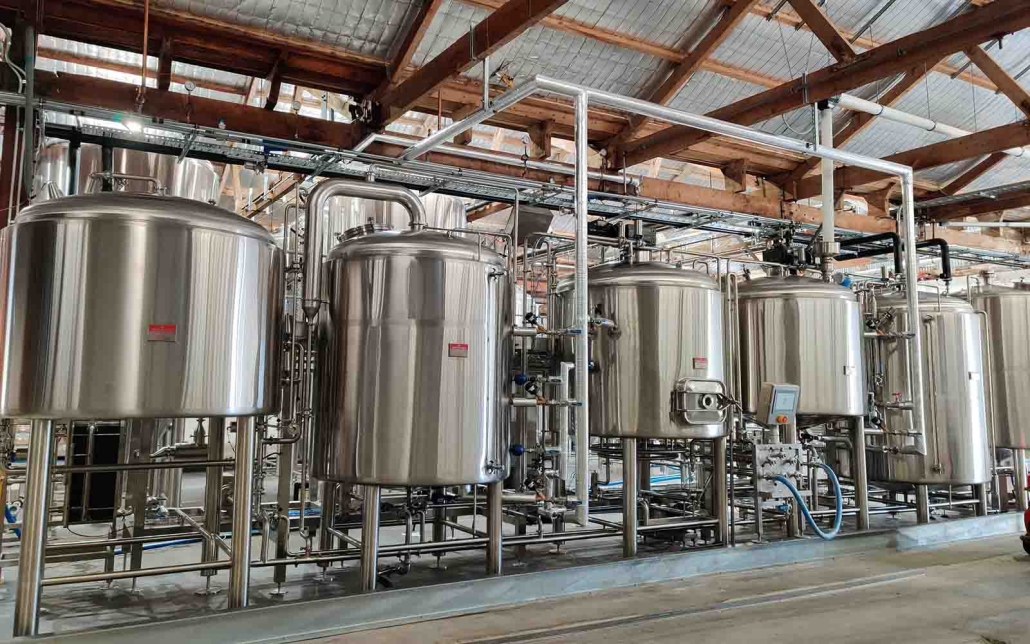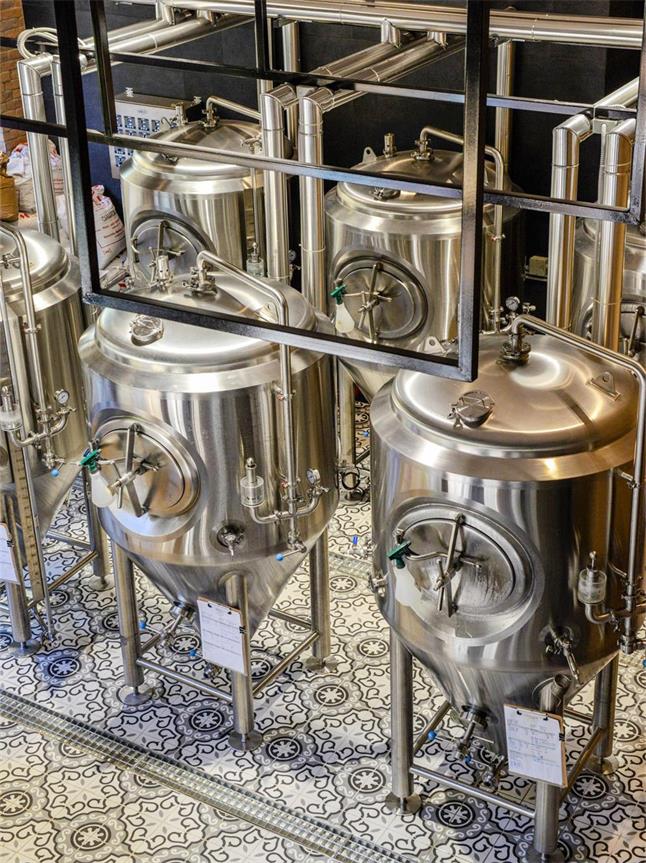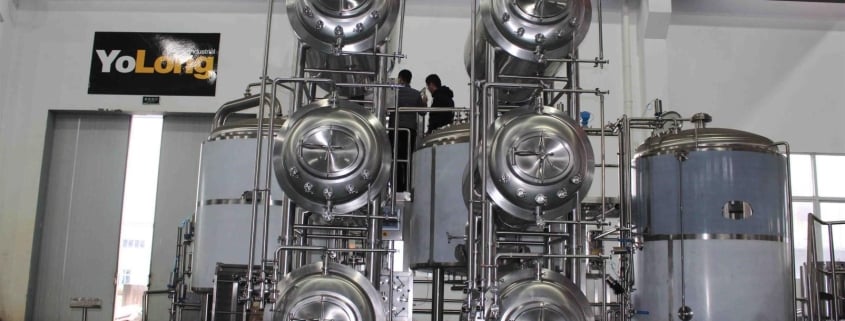Beer Fermentation Tanks
Beer fermentation tanks are essential equipment for proper beer production. This guide provides a comprehensive overview of beer fermentation tank types, sizes, layouts, suppliers, prices, and technical considerations for installation, operation, and maintenance.
Overview of Beer Fermentation Equipment
Beer fermentation is a critical step in brewing where yeast converts sugars into alcohol and carbon dioxide. Proper temperature control, agitation, and yeast health optimization during fermentation ensures high quality, consistent beer output.
Special fermentation tanks are used to provide optimum conditions for yeast activity. Key equipment pieces include:
Fermentation Vessels – Cylindroconical stainless steel tanks that hold beer during the fermentation process. Available in different diameter to height ratios. Fitted with cooling jackets, agitators, yeast collection systems and CIP sprayballs.
Temperature Control Systems – Cooling jackets around tanks use glycol/ammonia/freon systems to maintain steady fermentation temperature profile.
Yeast Propagation Systems – Special mini fermenters to grow sufficient healthy yeast for pitching into main fermentation tanks.
Yeast Storage Tanks – After fermentation, yeast sediment is collected and stored for reuse.
Carbonation Systems – Equipment for controlled injection of CO2 post-fermentation prior to bright beer tank storage.
Monitoring & Automation – Sensors, transmitters, process controllers are used to track temperature, density, pH and automate tank processes.
Proper fermentation tank configuration is critical for efficient beer production, quality and yield.

Beer Fermentation Tank Types
Many fermenter tank designs exist for different batch sizes, beer types and workflow formats. Main equipment configurations include:
| Tank Type | Description |
|---|---|
| Cylindroconical Tanks | Cone bottom tank with cylindrical upper section. Most common design with efficient yeast separation. Available from few BBLs to thousands of BBLs capacity. |
| Open Fermenters | Flat/sloped bottom, open top rectangular vessels. Allow easy access for fruit/ingredient addition. Limited to certain ale beer styles suited to ambient exposure. |
| Closed Fermenters | Cylindrical tanks with dish/conical bottom and closed top. Range from 5 to 30 BBLs. Used for ales and lagers. |
| Horizontal Fermenters | Cylindrical tanks placed in horizontal orientation. Require less vertical headroom. Up to 800 bbls. |
| Mixed Fermentation | Combination of vessel types for primary and secondary fermentation steps. Open tanks used for initial activity followed by closed tanks. |
Beer Fermentation Tank Sizes
Beer fermentation tanks cover a wide range of sizes from a few barrels to massive volumes over 1000 barrels. Some typical fermenter capacities include:
- Pilot Systems: 1-3 BBL
- Microbreweries: 3-7 BBL, 7-30 BBL
- Pub Breweries: 15-30 BBL
- Production Breweries: 30-300 BBL, 600-800 BBL, 1000+ BBL
Larger tanks have advantages of higher volume and less cleaning/handling per barrel but need substantial space and capital investment. Smaller tanks provide flexibility for more beer varieties.
Typical fermentation tank size selection considers:
- Annual beer production targets
- Peak seasonal production capacity
- Floorspace and height constraints
- Budget
With multiple fermenters, it is also important to have the right tank mixing – small and large units that can handle both flagship brews and experimental pilot batches.
Beer Fermentation Tank Designs
Fermenter tanks have different designs and accessory fittings tailored to facility requirements:
| Parameter | Options | Advantages | Limitations |
|---|---|---|---|
| Geometry | Cylindroconical <br> Horizontal Cylindrical <br> Open Top Rectangular | Efficient yeast settling <br> Height reduction <br> Accessibility | Tall height <br> Difficult CIP <br> Exposure risk |
| Construction | Stainless Steel <br> Aluminum <br> Plastic | Durable, impermeable <br> Cost-effective <br> Disposable | Cost <br> Reactive material <br> Single-use |
| Heating/Cooling | Cooling Jacket <br> Internal Cooling Coil <br> External Heating/Cooling | Uniform temperature <br> No contamination risk <br> Flexible applications | Complex install <br> Limited cooling <br> Hardware requirements |
| Agitation | Top-mounted mechanical <br> Side-mounted mechanical <br> Airlift pneumatic | Full mixing profile <br> Avoid top intrusions <br> No sealing requirements | Bearing maintenance <br> Shear effects <br> Weaker mixing |
| Yeast Handling | Conical bottom <br> External separator tank <br> Slope sheets | Compact design <br> Adjustable capacities <br> Easier cleaning | Height needs <br> Additional tank space <br> Leveling requirements |
Planning Beer Fermentation Tank Layout
Fermentation room layout balances production workflow, equipment spacing, service access and expansion flexibility:
- Linear layout places tanks in a single row
- Cluster layout groups tanks together with open workflows
- Compact layout fits more tanks by minimizing aisle space
- Modular layout has moveable racks and standardized spacing
- Multi-level layout uses second level mezzanines for small FVs
20% extra area should be allocated for tank maintenance access and yeast propagation systems. FV orientation relative to other equipment in brewhouse impacts slurry transfers, cleaning, forklift logistics etc.
Customization Options for Beer Fermentation Tanks
In addition to standard tank accessories like cooling jackets, agitators, CIP components etc., customizations enable unique capabilities:
Automatic yeast pitching – Density sensors trigger pumps for pitching at the right fermentation phase
In-tank dry hopping – Special tank bottom section for dry hop addition without opening the tank
Advanced automation – Touchscreen controllers, remote monitoring and data analytics integration
Hybrid uni/multivessel – Single FV switches between unitary and multivessel modes
Pressure/vacuum rating – Withstand high CO2 volumes or vacuum conditions for specialty processes
Steam jackets – Live steam injection for temperature boost or hot water sanitization
** canker**- Internal or external tank cladding for insulation benefits
Such custom features help enhance efficiency, reduce labour and enable novel processing techniques but add cost and complexity. Brewers should assess value proposition for bespoke designs versus off-the-shelf standard tanks on a case-by-case basis.
Beer Fermentation Tank Suppliers & Pricing
Many brewery equipment manufacturers supply fermentation tanks with sizes and configurations for all scales of production. A partial list includes:
| Supplier | Location | Price Range |
|---|---|---|
| JVNW | USA | $4,000 – $250,000 |
| Spike Brewing | USA | $6,500 – $100,000 |
| Ss Brewtech | USA | $7,500 – $150,000 |
| Premier Stainless | USA | $10,000 – $500,000 |
| Rolec Prozess | Germany | €5,000 – €300,000 |
| KEGGING | Italy | €7,000 – €150,000 |
Pricing varies based on material grade, volume, accessories and customizations ranging from $2,000 per BBL for basic mechanical tanks to over $10,000 per BBL for sophisticated automated FV systems.
Second-hand reconditioned tanks are also available at significant discount but have higher risk of defects and shorter remaining service lifespan. When requesting quotations, provide fermentation parameters, production targets, floorspace and layout constraints so vendors can appropriately size and configure tanks.
Installing and Operating Beer Fermentation Tanks
Proper fermenter installation, use and maintenance ensures optimal performance and longevity:
| Activity | Procedure | Frequency |
|---|---|---|
| Installation | Level tanks <br> Connect cooling lines <br> Wire control panels <br> Test sample batch | One-time |
| Cleaning | CIP with alkaline solution <br> Citric acid passivation <br> Hot water rinse | Each batch completion |
| Inspection | Check cooling jacket seals <br> Test sample valves <br> Inspect fittings/welds | Monthly |
| Maintenance | Replace aging cooling glycol <br> Rebuild agitator bearings <br> Inspect yeast dump valves | Yearly or per OEM specs |
Strict cleaning procedures between batches minimizes risk of contamination. Proactive inspections and preventative maintenance avoids unplanned downtime. Personnel must follow all standard safety protocols when working inside fermentation vessels.

Key Considerations for Selecting Beer Fermentation Tanks
Brewery Scale & Growth Plans
Match tank capacity and quantity to annual beer production targets. Factor in peak demand during seasonal spikes. Choose modular designs allowing incremental expansion without full system replacement.
Floor Plan Dimensions
Consider facility height, footprint and layout constraints. Measure doorway clearance, aisle width and overhead space to ensure tanks fit into building. Account for 20% extra space around tanks for operator movement and ancillary equipment.
Beer Variety Complexity
Simple lager portfolios need fewer larger fermenters while complex ales require more tanks with variable sizes for different recipes. Flexibility for short batch turnover around core brands allows innovation.
Budget Limitations
Weigh value of automation, exotic alloys and custom features versus basic functionality. Prioritize must-have accessories over nice-to-have upgrades given finite capex allocation.
In-House vs Turnkey Expertise
Evaluate ability to self-install tanks or outsource to specialists. Complex integrated systems with advanced automation may warrant vendor turnkey project. Simpler tanks can be DIY using modular designs and supplier support.
Future-Proofing Scope
Anticipate emerging beer trends, novel ingredients, and processing innovations that could require fermentation flexibility in 5-10 years. Choose designs accommodating projected needs via customization potential.
Regulatory Approvals
Get supplier support during certification process for welding standards, sanitary design, hazardous environment compliance etc. required by local food safety and alcohol bureaus.













